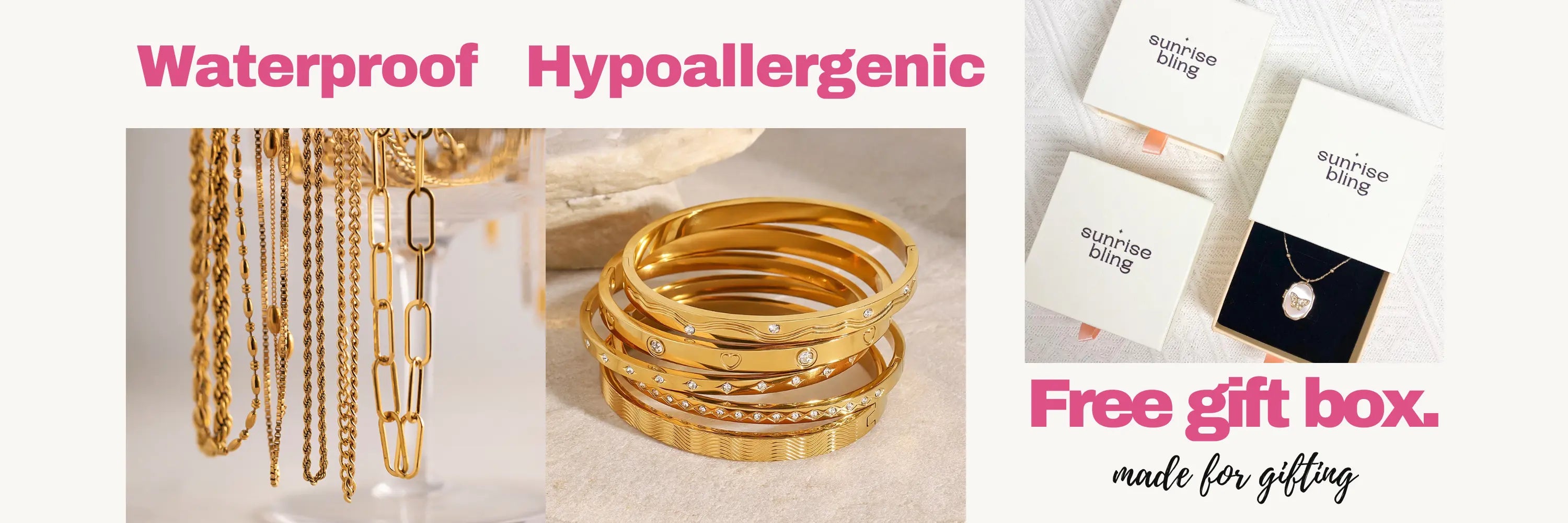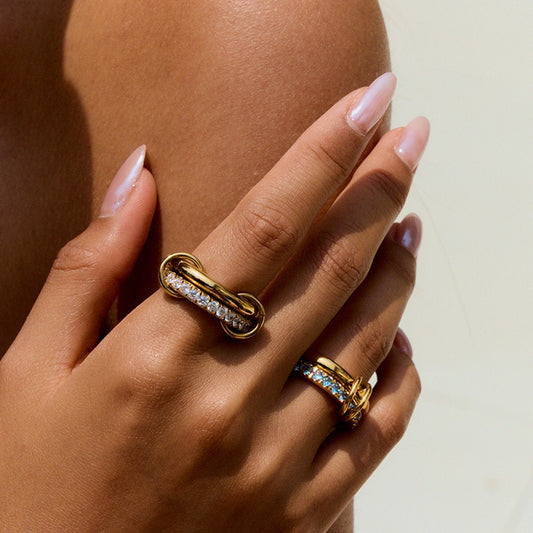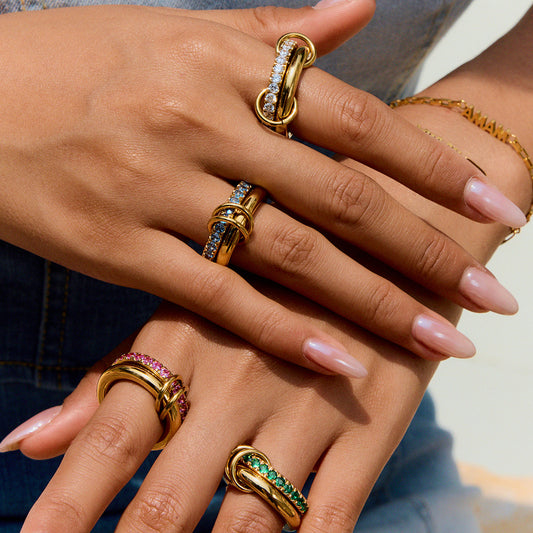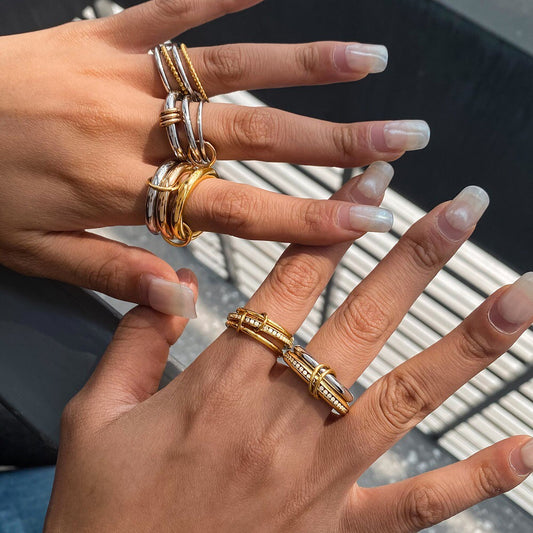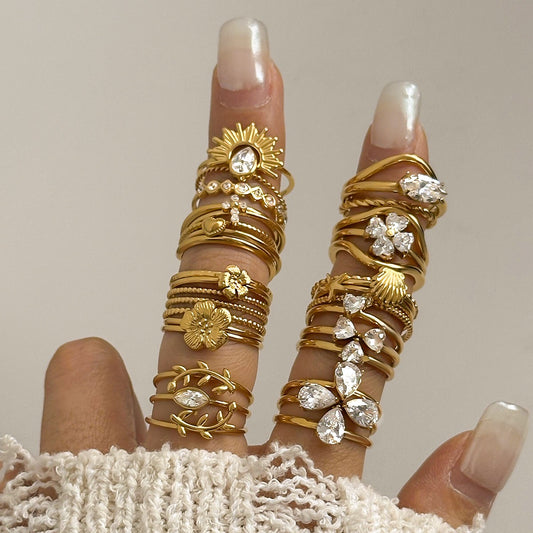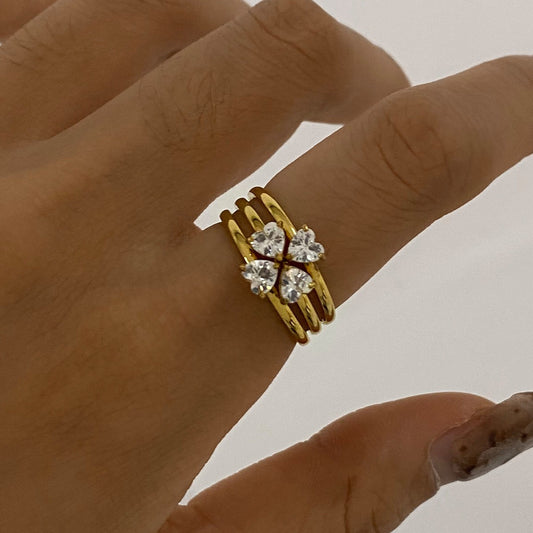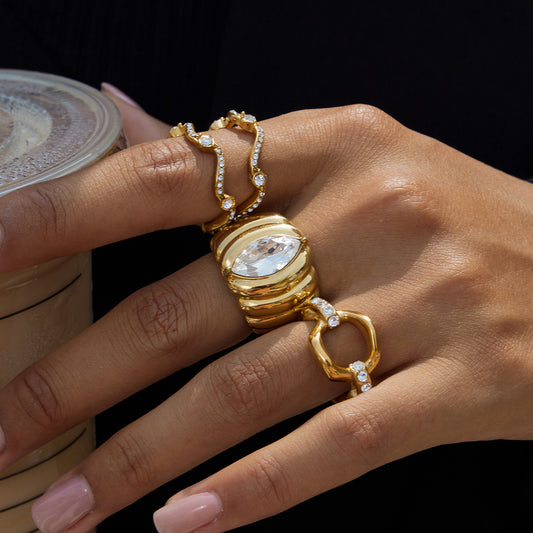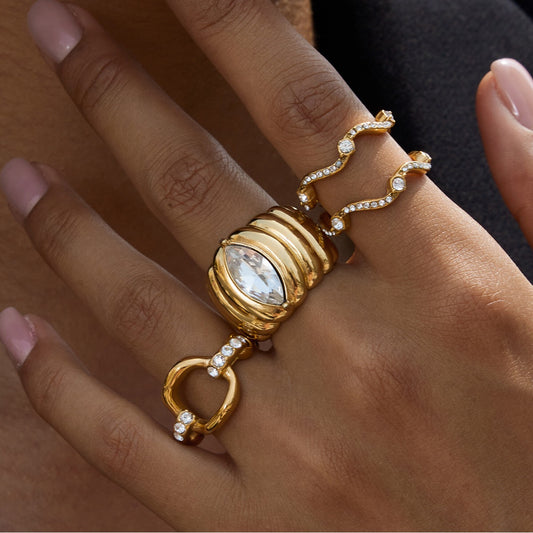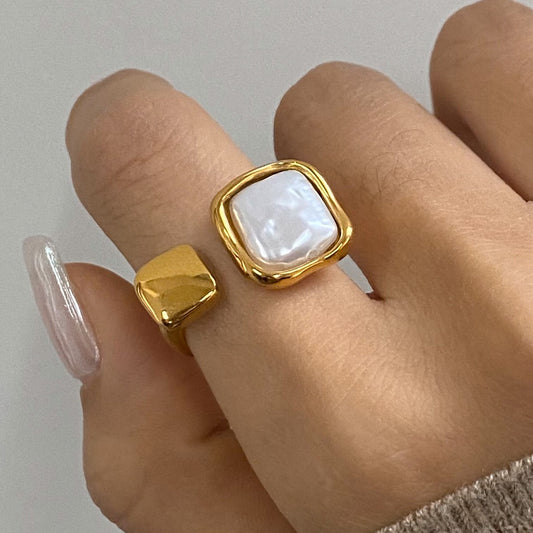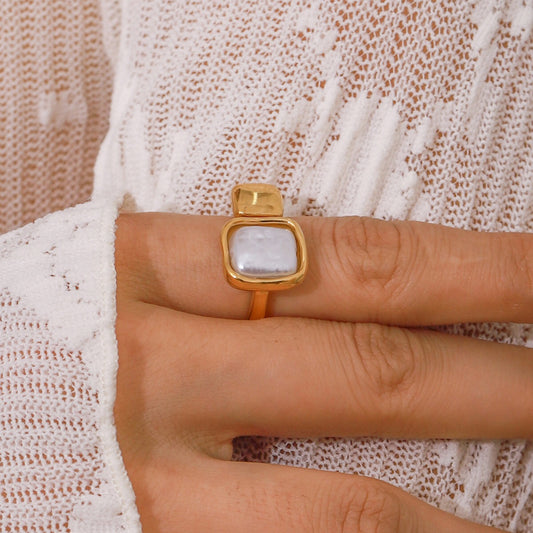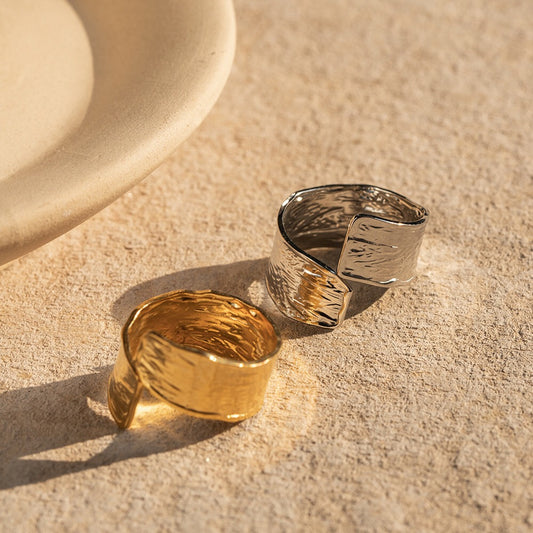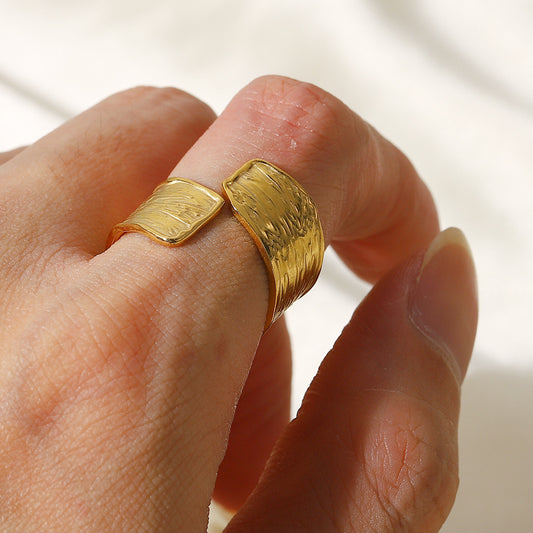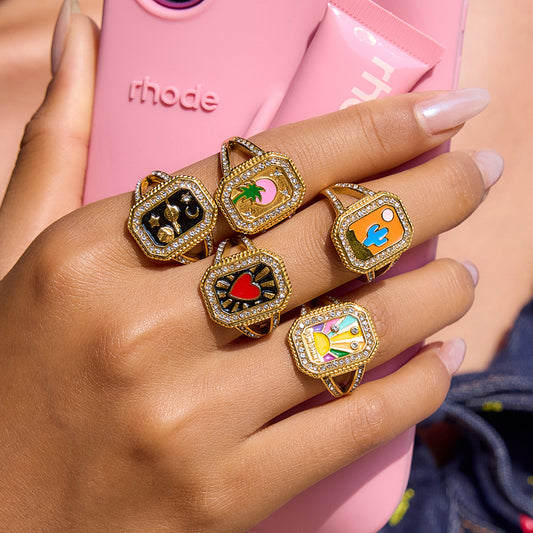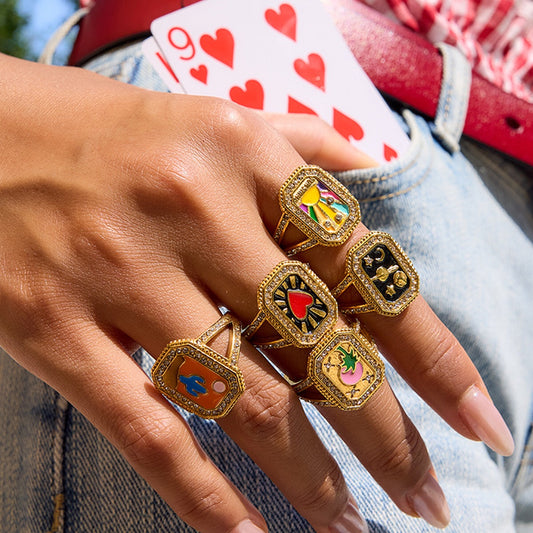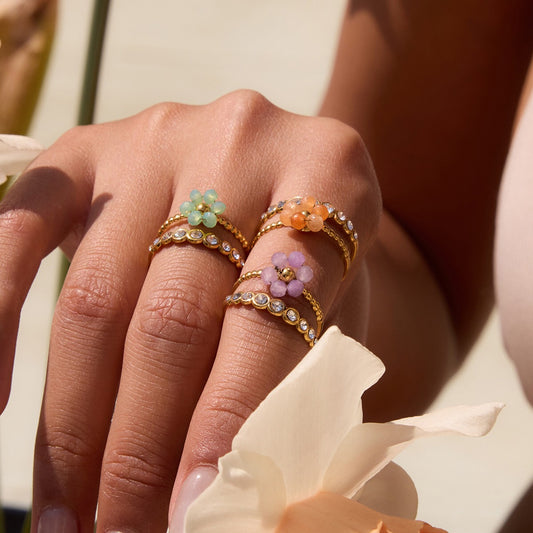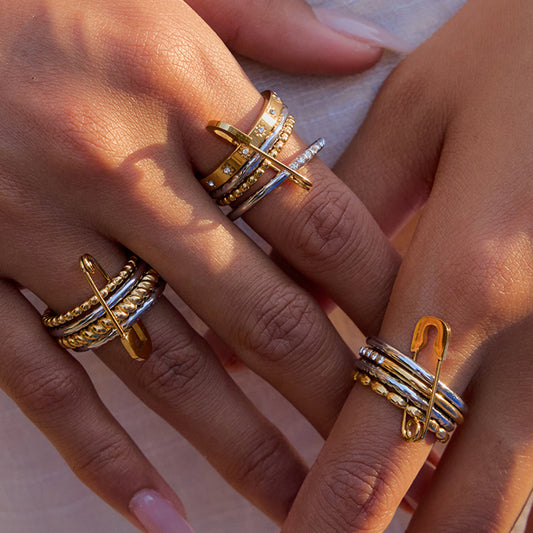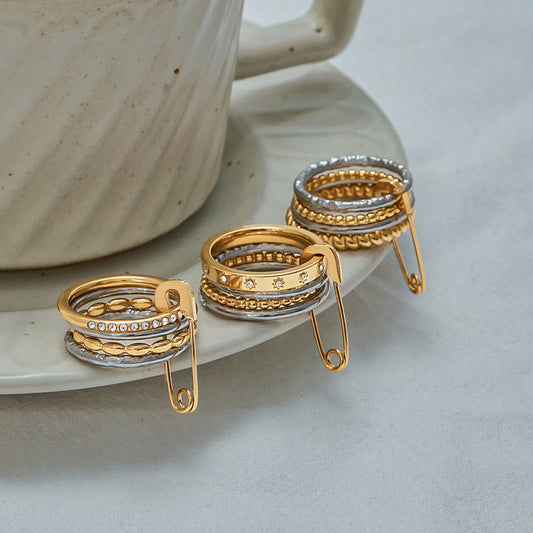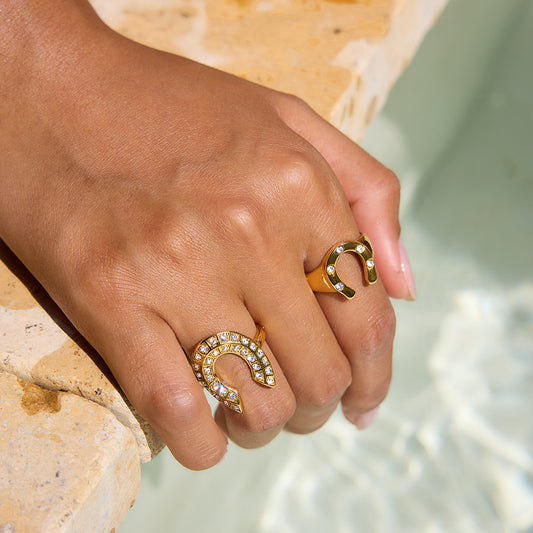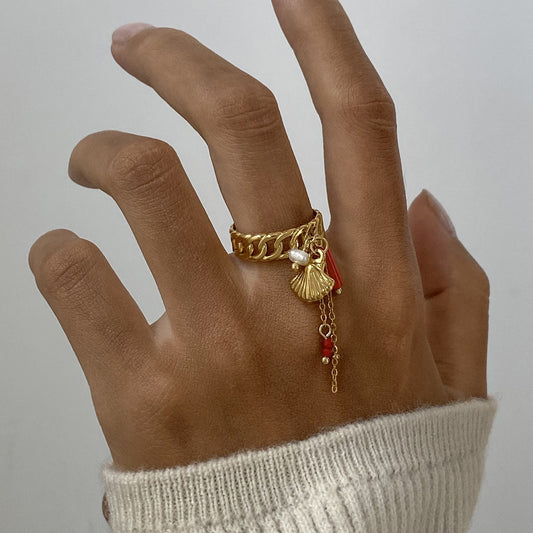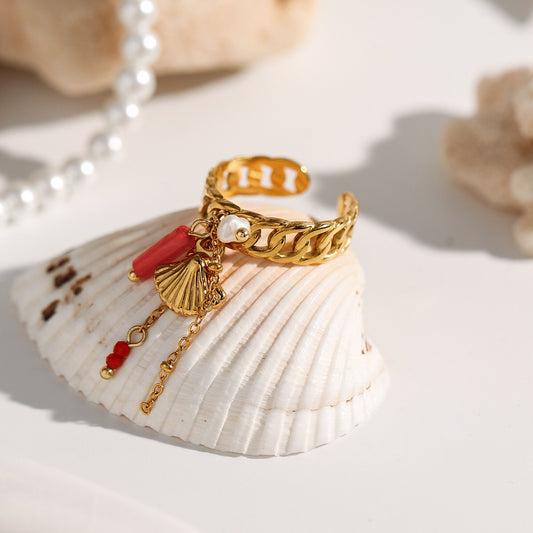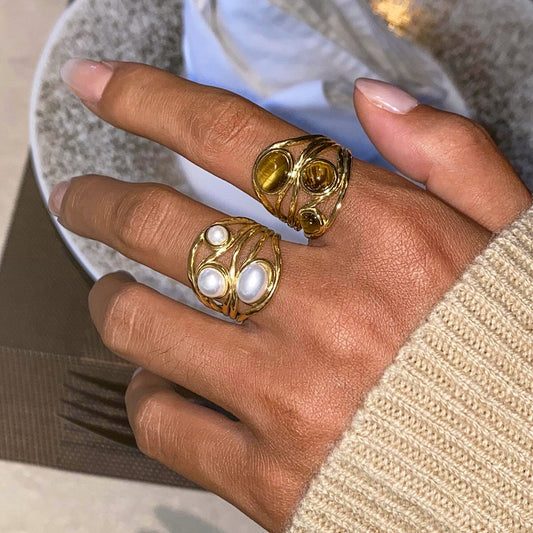Rings gold white (white gold rings) have become a staple in modern jewelry collections, living up to their tagline of “shine bright, stay classic” with their sleek silver-white luster and timeless appeal. The global jewelry market size was estimated at USD 366.79 billion in 2024 and is projected to reach USD 578.45 billion by 2033. This popularity stems from their unique blend of “shine bright” (a polished, reflective finish that rivals platinum) and “stay classic” (a design versatility that works for everyday wear, engagements, and special occasions). Unlike yellow gold (which leans warm) or rose gold (which feels romantic), white gold offers a neutral, sophisticated glow that complements any skin tone and outfit. Whether you’re looking for a minimalist band or a diamond-encrusted engagement ring, rings gold white deliver elegance that never feels dated. Let’s explore what makes these rings so beloved, how to style them, and how to keep their shine intact for years.

What is Rings Gold White
Definition and Core Composition
Rings gold white—commonly called white gold rings—are jewelry pieces crafted from white gold, an alloy of pure gold and white metals (to neutralize gold’s natural yellow hue). Pure gold (24k) is too soft for jewelry, so it’s mixed with stronger metals to create durable, wearable rings. The key components of white gold include:
-
Pure Gold: Makes up 58.3% of 14k white gold (the most common grade for rings) or 75% of 18k white gold—this ensures the ring retains gold’s value and luster.
-
White Metals: Typically nickel, palladium, or silver—these metals dilute gold’s yellow color to create a silver-white finish. Nickel is affordable but may irritate sensitive skin; palladium is hypoallergenic and more premium.
-
Rhodium Plating: Most white gold rings are coated with a thin layer of rhodium (a rare, silvery metal) to enhance their “shine bright” finish and protect against tarnish. This plating gives white gold its signature mirror-like glow.
How White Gold Differs from Other “White” Metals
It’s easy to confuse white gold with other silver-toned metals, but key differences set it apart:
-
vs. Platinum: Platinum is a pure white metal (no alloying needed) and denser than white gold—making it more durable but 2–3x more expensive. White gold is lighter and more affordable, with a similar shine when rhodium-plated.
-
vs. Silver: Silver is softer and more prone to tarnish; white gold is more durable and resistant to wear. Silver also has a warmer, grayer tone compared to white gold’s bright, cool shine.
-
vs. White Gold-Plated Jewelry: White gold-plated rings have a thin layer of white gold over a base metal (e.g., brass); genuine white gold is an alloy through-and-through. Plated rings wear off in 6–12 months, while genuine white gold lasts decades.
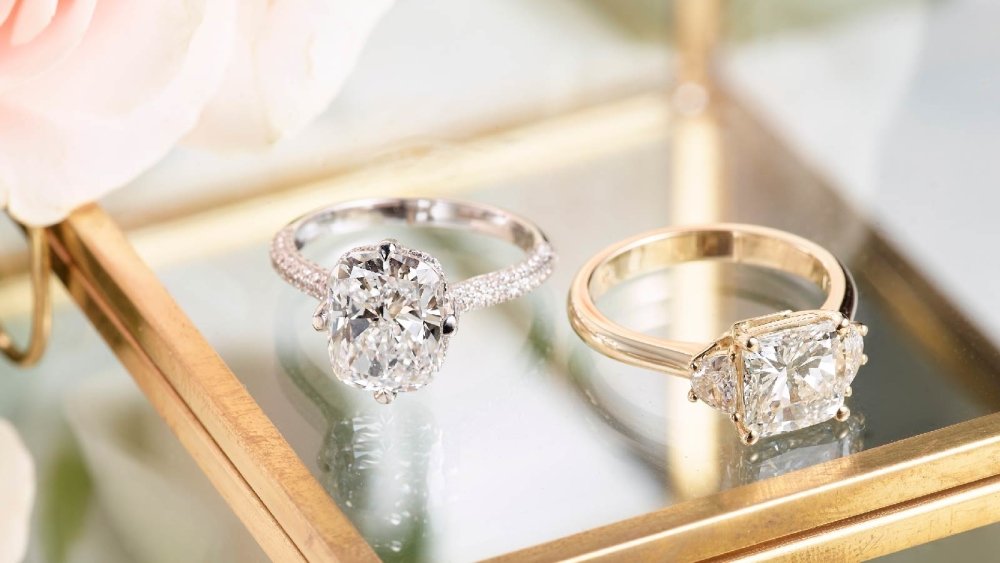
Common Grades of White Gold for Rings
Two grades dominate the white gold ring market, each balancing durability, value, and shine:
-
14k White Gold: Contains 58.3% gold, 25% nickel/palladium, and 16.7% other metals. The most popular choice for everyday rings—it’s durable enough for daily wear (resists scratching) and more affordable than 18k.
-
18k White Gold: Contains 75% gold, 15% palladium, and 10% other metals. Has a richer, slightly warmer white tone (due to higher gold content) and is more valuable—ideal for engagement rings or luxury pieces.
Why is Rings Gold White so popular
“Shine Bright, Stay Classic” Core Appeal
The top reason rings gold white are popular is their ability to deliver “shine bright, stay classic” in one piece. The rhodium plating gives them a brilliant, reflective shine that catches light (perfect for drawing attention to engagement rings or statement bands), while their neutral tone ensures they never go out of style. Unlike trendy metals (e.g., black plated steel), white gold has been a jewelry staple for decades and will remain elegant for years to come.
Complements Every Skin Tone
White gold’s cool, silvery tone flatters all skin tones—a rare trait in jewelry metals:
-
Warm Skin Tones (Yellow/Peach Undertones): White gold contrasts beautifully with warm skin, brightening the complexion without clashing.
-
Cool Skin Tones (Pink/Blue Undertones): White gold harmonizes with cool skin, enhancing a natural, radiant look.
-
Neutral Skin Tones: White gold complements both warm and cool colors, making it versatile for any outfit.
Versatility Across Occasions and Styles
Rings gold white adapt to every vibe, from casual to formal:
-
Everyday Wear: A simple 14k white gold band works with jeans and a tee, adding subtle shine without feeling over-the-top.
-
Workwear: A thin white gold ring with a tiny diamond accent is office-appropriate—professional enough for meetings, but with enough sparkle to feel polished.
-
Formal Events: A white gold engagement ring with a diamond halo or a gemstone (e.g., sapphire) elevates evening gowns, offering “shine bright” glamour that’s timeless.

Value and Durability
White gold rings offer a balance of value and longevity:
-
Value: As an alloy of pure gold, white gold retains its value over time (unlike silver or plated metals). It’s a more affordable alternative to platinum but still feels luxurious.
-
Durability: 14k white gold is scratch-resistant and can withstand daily wear (e.g., typing, cooking) without bending or breaking. With proper care (re-plating every 2–3 years), it can last a lifetime.
Popular styles of Rings Gold White
Minimalist White Gold Rings
-
Slim Band: A thin (2–3mm) 14k white gold band with a polished finish. Perfect for everyday wear or stacking with other rings. Some have subtle textures (e.g., brushed metal) for added depth.
-
Solitaire Ring: A single gemstone (usually a diamond, but also birthstones like emerald or ruby) set in a simple white gold band. The “shine bright” of the gem and white gold makes this a classic engagement ring style.
-
Stackable Bands: Thin white gold bands (1–2mm) with tiny details (e.g., micro-pavé diamonds, engraved lines). Designed to be worn together—mix 2–3 for a layered look that’s trendy yet timeless.
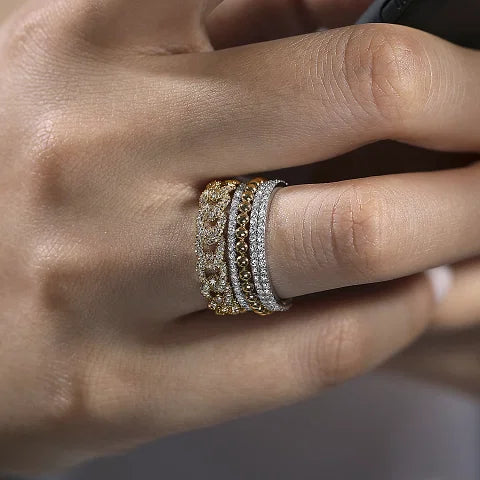
Statement White Gold Rings
-
Halo Ring: A central gemstone (e.g., a 1-carat diamond) surrounded by a “halo” of small diamonds, all set in white gold. The halo amplifies the “shine bright” effect, making the central gem look larger and more sparkling.
-
Three-Stone Ring: Three gemstones (often diamonds or a mix of diamonds and colored gems) set in a white gold band. Symbolizes “past, present, future”—a popular choice for engagement or anniversary rings.
-
Vintage-Inspired Ring: White gold rings with retro details (e.g., filigree metalwork, milgrain edges, or old-cut diamonds). The cool white gold contrasts beautifully with vintage designs, giving them a modern twist.
Personalized White Gold Rings
-
Engraved Band: A white gold band engraved with names, dates, or quotes (e.g., “I love you” or a wedding date). The engraving is often filled with black enamel to make it stand out against the white gold.
-
Birthstone Ring: A white gold ring with one or more birthstones (e.g., a mother’s ring with her children’s birthstones). The colored gems pop against the white gold, adding personal meaning and color.
-
Coordinate Ring: A white gold band or pendant ring engraved with latitude/longitude coordinates (e.g., of a first date or hometown). Subtle yet meaningful—perfect for everyday wear.
How to wear Rings Gold White
Everyday Casual Vibe
-
Jeans and a Tee: Pair a slim 14k white gold band with high-waisted blue jeans, a white graphic tee, and sneakers. The ring adds “shine bright” subtlety to the casual look without overwhelming it.
-
Leggings and Oversized Sweater: Wear a stack of 2–3 thin white gold bands (one with micro-pavé diamonds, two plain) with black leggings, an oversized cream sweater, and ankle boots. The layered rings add texture and polish to the cozy outfit.
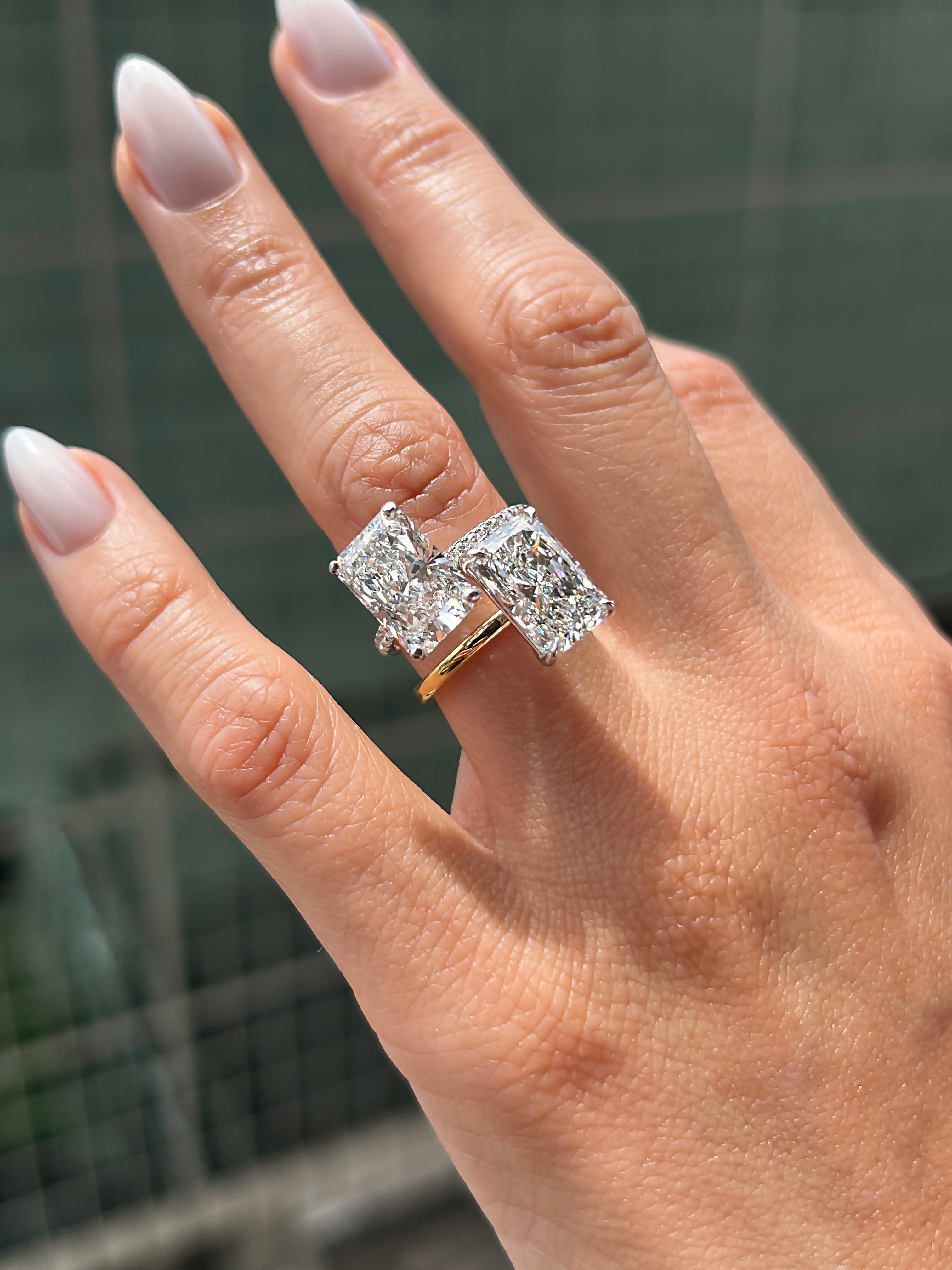
Professional Work Vibe
-
Blazer and Tailored Pants: Opt for a white gold solitaire ring (small diamond, 0.25 carats) with a navy blazer, white silk blouse, and tailored black pants. The ring’s “shine bright” is office-appropriate—understated but enough to show you care about your appearance.
-
Midi Skirt and Button-Down: A white gold three-stone ring (diamonds or birthstones) pairs with a light blue button-down, beige midi skirt, and loafers. The ring adds a touch of personality without distracting during meetings.
Formal Event Vibe
-
Date Night: Wear a white gold halo ring (central diamond with a diamond halo) with a little black dress and strappy heels. The halo’s “shine bright” effect catches light, making the ring the focal point of the outfit.
-
Wedding Guest: A vintage-inspired white gold ring (filigree details with small pearls) complements a floral midi dress and wedges. The ring’s classic design fits the festive occasion, and the white gold pairs beautifully with pastels or bold prints.
Styling Tips
-
Mix with Other Metals: White gold pairs seamlessly with yellow or rose gold—e.g., stack a white gold band with a rose gold band for a trendy two-tone look.
-
Balance with Other Jewelry: If wearing a statement white gold ring (e.g., halo style), keep earrings and necklaces minimal (e.g., small white gold studs) to avoid clutter.
-
Match to Outfit Accents: White gold complements silver zippers, white buttons, or cool-toned fabrics (e.g., navy, gray) —use these accents to tie your look together.
Rings Gold White: perfect gift for your girlfriend
“Shine Bright” Symbolizes Your Love
A white gold ring is a perfect gift for your girlfriend because its “shine bright” finish mirrors the brightness of your relationship. Unlike generic gifts, a white gold ring feels special—it’s a tangible reminder of your love that she can wear daily, not just put on a shelf. Whether it’s a simple band or a birthstone design, the ring’s classic appeal shows you’re thinking long-term, not just about the moment.
Fits Her Style (No Matter What She Likes)
With so many white gold ring styles, you can find one that matches her aesthetic:
-
Minimalist Girlfriend: A thin 14k white gold band with a brushed finish—simple, elegant, and perfect for everyday wear.
-
Glamorous Girlfriend: A white gold halo ring with a small diamond or colored gem (e.g., her birthstone)—sparkly enough for special occasions but still wearable.
-
Sentimental Girlfriend: An engraved white gold band with your anniversary date or a short quote (e.g., “My person”)—personalized and meaningful.
Durable Enough for Her Daily Routine
White gold rings are tough enough to keep up with her busy life. Whether she’s a student, a nurse, or an artist, she can wear the ring daily without worrying about scratches, tarnish, or bending. Unlike delicate jewelry (e.g., pearl rings), white gold is low-maintenance—just a quick wipe with a cloth keeps it shining.
Hypoallergenic Options for Sensitive Skin
If your girlfriend has sensitive skin (and reacts to nickel), opt for a palladium-based white gold ring (instead of nickel-based). Palladium is hypoallergenic, so she can wear the ring all day without redness or itching. This attention to her comfort shows you care about the little details, making the gift even more thoughtful.
How to clean Rings Gold White
Supplies Needed
-
Mild dish soap (unscented, dye-free)
-
Warm water (not hot—hot water can damage rhodium plating)
-
Soft-bristled toothbrush (unused, for small crevices)
-
Lint-free cloth (microfiber or cotton)
-
Jewelry polishing cloth (specifically for gold—avoid abrasive cloths)
Step-by-Step Cleaning Process
-
Basic Daily Cleaning:
-
Wipe the white gold ring with a dry lint-free cloth after wear to remove sweat, lotion, or dirt—this prevents buildup that can dull the rhodium plating.
-
Deep Cleaning (Every 2–3 Weeks):
-
Mix 1 drop of mild dish soap with 1 cup of warm water in a small bowl.
-
Submerge the ring and let it soak for 5–10 minutes—this loosens grime without damaging the plating or gemstones (if any).
-
Gently scrub the ring with the soft toothbrush—focus on the back of the band (where skin oils build up) and around gemstone settings (dirt often hides here).
-
Rinse thoroughly under warm water, then pat dry with a lint-free cloth. Avoid air-drying—water spots can form on the rhodium plating.
-
Restoring Shine (If Dull):
-
Use a gold-specific polishing cloth to gently buff the ring in circular motions. This removes minor scratches and restores the “shine bright” finish.
-
Do not use silver polish or abrasive cleaners—they can wear off the rhodium plating, revealing the underlying yellow gold.
Maintenance Tips to Preserve Plating and Shine
-
Remove Before Activities: Take off the ring before swimming (chlorine damages rhodium plating), showering (water can loosen gemstones), or applying perfume/lotion (chemicals dull the finish).
-
Store Properly: Keep the ring in a soft jewelry pouch or a lined jewelry box compartment (separate from other jewelry) to avoid scratches. Scratches can wear through the rhodium plating faster.
-
Re-Plate Every 2–3 Years: Over time, rhodium plating wears off (especially with daily wear), revealing the yellowish undertone of white gold. Take the ring to a jeweler for re-plating—this costs \(50–\)100 and restores the “shine bright” finish.
How do you make white gold ring
Step 1: Alloying Gold with White Metals
The process starts with creating white gold alloy:
-
Melting Pure Gold: Jewelers melt 24k pure gold in a high-temperature furnace (around 1,064°C) until it becomes a liquid.
-
Adding White Metals: Depending on the grade (14k or 18k), they add measured amounts of white metals (nickel, palladium, or silver) to the molten gold. For 14k white gold, 41.7% white metals are added; for 18k, 25% are added.
-
Mixing and Cooling: The mixture is stirred thoroughly to ensure even color, then poured into molds to form ingots (solid bars of white gold). These ingots cool and harden for 12–24 hours.
Step 2: Shaping the Ring Band
Next, the ingot is transformed into a ring band:
-
Rolling the Ingot: The ingot is passed through a rolling mill to flatten it into a thin sheet or draw it into a wire (depending on the ring style—band or solitaire).
-
Bending and Sizing: The sheet or wire is bent into a circular shape using a ring mandrel (a tapered metal rod). Jewelers adjust the size to match the desired ring size (e.g., size 6 or 7).
-
Soldering the Seam: The ends of the bent metal are heated and soldered together to form a closed band. The seam is then filed and polished to make it smooth and invisible.
Step 3: Adding Details (Pendants, Gem Settings)
For rings with gemstones or engravings, additional steps are added:
-
Creating Settings: If the ring has a gemstone (e.g., solitaire or halo), jewelers carve or stamp prongs, bezels, or halos into the band to hold the gem securely.
-
Setting Gemstones: The gemstone is placed in the setting, and prongs are bent over the edges to secure it (for prong settings) or a bezel is pressed around it (for bezel settings).
-
Engraving: If the ring is personalized, jewelers use a laser or hand tool to engrave names, dates, or quotes onto the band. The engraving may be filled with enamel for contrast.
Step 4: Rhodium Plating and Polishing
The final step ensures the “shine bright” finish:
-
Cleaning the Ring: The ring is soaked in a ultrasonic cleaner to remove any dirt or debris from the shaping process.
-
Rhodium Plating: The ring is dipped into a rhodium plating solution and electrified (electroplating). A thin layer of rhodium (0.1–0.5 microns thick) adheres to the white gold, giving it a bright, silvery finish.
-
Final Polishing: The ring is buffed with a soft cloth to enhance its shine, then inspected for quality (no scratches, secure gemstones, even plating).
Why is my white gold ring turning yellow
The Main Cause: Worn Rhodium Plating
The most common reason a white gold ring turns yellow is worn rhodium plating. As we explained earlier, white gold’s bright silver finish comes from a thin rhodium coating—not the white gold alloy itself. Underneath that plating, white gold has a natural pale yellow or grayish-yellow tone (since it’s still mostly pure gold, which is yellow). Over time, daily wear rubs off the rhodium:
-
High-Touch Areas: The inside of the band (where it rubs against your finger) and the top of the ring (where it scrapes against clothing, keyboards, or bags) lose plating first.
-
Frequency of Wear: Rings worn 24/7 (like wedding bands) lose plating faster (1–2 years) than occasional wear rings (3–4 years).
Other Factors That Speed Up Yellowing
-
Harsh Chemicals: Chlorine (swimming pools), bleach (cleaning products), perfume, and lotion break down rhodium plating. Even hand sanitizer (high in alcohol) can strip the coating over time.
-
Sweat and Oil: Skin oils and sweat contain acids that slowly erode rhodium. People who sweat heavily may notice yellowing faster.
-
Low-Quality Plating: Cheap white gold rings often have thin rhodium plating (less than 0.1 microns), which wears off in months instead of years.
How to Fix a Yellowing White Gold Ring
-
Re-Plate It: The simplest solution—take the ring to a jeweler for rhodium re-plating. This costs \(50–\)100 and restores the “shine bright” silver finish in 1–2 days. Most jewelers recommend re-plating every 2–3 years for daily wear rings.
-
Polish Gently: For minor yellowing (only a small area), use a gold-specific polishing cloth to buff the surface. This won’t restore rhodium, but it can brighten the remaining plating temporarily.
-
Prevent Future Wear: Remove the ring during activities that damage plating (swimming, cleaning, applying products) to extend the time between re-plating sessions.
How much is a 14k white gold ring worth
The value of a 14k white gold ring depends on two main factors: the weight of the white gold alloy and any additional features (like gemstones or engravings). Below is a breakdown of how to calculate its worth:
1. Base Value: Weight of the 14k White Gold Alloy
14k white gold is 58.3% pure gold, so its value is tied to the current market price of gold (often called the “spot price”). As of 2024, the spot price of gold is approximately \(2,000 per ounce (or \)64.30 per gram). Here’s how to calculate the base value:
-
Step 1: Weigh the Ring: Use a jewelry scale to get the weight in grams (most 14k white gold bands weigh 2–5 grams; engagement rings with settings weigh 3–7 grams).
-
Step 2: Calculate Pure Gold Weight: Multiply the ring’s total weight by 0.583 (the percentage of pure gold in 14k). For example, a 3-gram ring has 3 × 0.583 = 1.749 grams of pure gold.
-
Step 3: Multiply by Spot Price: Multiply the pure gold weight by the current spot price per gram. Using the 2024 spot price (\(64.30/gram): 1.749 × \)64.30 ≈ $112.56.
This is the “intrinsic value” of the white gold itself—what a jeweler would pay for the metal if the ring were melted down.
2. Additional Value: Gemstones, Brand, and Condition
-
Gemstones: Diamonds or colored gems add significant value. For example:
-
A small diamond (0.1 carats, SI1 clarity, G color) adds \(100–\)200.
-
A larger diamond (0.5 carats, VS2 clarity, F color) adds \(1,500–\)3,000.
-
Colored gems (sapphires, emeralds) add value based on size and quality (a 0.5-carat sapphire adds \(300–\)800).
-
Brand: Designer rings (e.g., Tiffany & Co., Cartier) have a “premium” value—they may sell for 2–3x the intrinsic value due to brand recognition.
-
Condition: Rings in excellent condition (no scratches, intact rhodium plating) are worth more than damaged ones. A ring with worn plating or bent prongs may sell for 10–20% less.
Example Value Ranges for 14k White Gold Rings
-
Simple Band (2–3 grams, no gemstones): \(80–\)150 (intrinsic value)
-
Diamond Solitaire (3–4 grams, 0.25-carat diamond): \(300–\)600
-
Designer Ring (4–5 grams, small diamond, e.g., Pandora): \(200–\)400
-
Engagement Ring (5–7 grams, 0.5-carat diamond): \(2,000–\)4,500
Where to Get an Accurate Appraisal
For a precise value (especially for engagement rings or designer pieces), get a professional appraisal from a certified gemologist. They’ll assess the gold weight, gem quality, and brand, then provide a written valuation—useful for insurance, selling, or estate planning.
Frequently asked questions about Rings Gold White
Is 14k or 18k white gold better for everyday wear?
14k white gold is better for everyday wear—here’s why:
-
Durability: 14k has more alloy metals (41.7%) than 18k (25%), making it harder and more scratch-resistant. It can withstand daily activities (typing, cooking) without bending or showing wear.
-
Cost: 14k is more affordable, so if it gets scratched or needs re-plating, the cost to repair is lower.
-
Plating Longevity: 14k’s harder surface helps rhodium plating last longer than 18k (which is softer, so plating wears off faster).
18k white gold is better for special occasions or pieces you don’t wear daily—it has a richer tone and higher gold content, but it’s more prone to damage.
Can white gold rings cause skin irritation?
It depends on the alloy:
-
Nickel-Based White Gold: Most 14k white gold uses nickel to lighten the color—and nickel is a common allergen. 10–15% of people with sensitive skin may get red, itchy skin from nickel.
-
Palladium-Based White Gold: A hypoallergenic alternative—palladium doesn’t cause irritation, making it safe for sensitive skin. It’s more expensive than nickel-based white gold but worth it for comfort.
To avoid irritation, look for “nickel-free” or “hypoallergenic” white gold rings (usually labeled as palladium-based) when shopping.
How long does rhodium plating last on a white gold ring?
Rhodium plating lasts 1–3 years for daily wear rings, depending on:
-
Wear Frequency: Rings worn 24/7 (wedding bands) last 1–2 years; occasional wear rings (date night bands) last 2–3 years.
-
Activity Level: People with active lifestyles (gym, gardening) may need re-plating every 6–12 months.
-
Plating Thickness: Thick plating (0.3–0.5 microns) lasts longer than thin plating (0.1 microns).
You’ll know it’s time to re-plate when you see yellow spots (the underlying white gold) peeking through.
Can white gold rings be resized?
Yes—most white gold rings can be resized, but it’s important to work with a skilled jeweler:
-
Simple Bands (No Gemstones): Easy to resize—jewelers cut the band, add/remove metal, and solder it back together. They’ll then re-plate the resized area to match the rest of the ring.
-
Rings with Gemstones: Tricker if gemstones are near the band (e.g., halo or channel-set rings). Jewelers may need to temporarily remove stones to avoid damage during resizing.
-
Limitations: Most rings can be resized 1–2 sizes up or down. Resizing more than that may weaken the band or distort the design.
Is white gold a good investment compared to yellow gold or platinum?
White gold is a solid mid-range investment:
-
vs. Yellow Gold: Yellow gold has slightly higher intrinsic value (since it’s often not rhodium-plated and is more in demand for investment pieces like bars). However, white gold’s value is still tied to gold spot prices—both retain value over time.
-
vs. Platinum: Platinum is rarer and more valuable than white gold (2–3x the price), but it’s also denser and harder to work with. White gold is a more affordable alternative that still holds its value, making it better for most jewelry buyers.
For investment purposes, focus on high-quality 14k or 18k white gold rings (not plated) with minimal gemstones—their value is easier to track and resell.
Conclusion: Rings Gold White – Shine Bright, Stay Classic
Rings gold white (white gold rings) embody the perfect blend of “shine bright” glamour and “stay classic” versatility—no wonder they’re a top choice for everyday wear, engagements, and gifts. From their rhodium-plated luster that flatters every skin tone to their durable 14k alloy that stands up to daily life, these rings offer both style and practicality. Whether you’re troubleshooting a yellowing band, calculating the value of a 14k ring, or shopping for a gift for your girlfriend, white gold’s timeless appeal ensures it will remain a jewelry staple for years to come.
Ready to find your own “shine bright, stay classic” white gold ring? Explore our curated collection today—featuring 14k and 18k white gold bands, diamond solitaires, and personalized engraved rings. We offer free rhodium plating checks (to keep your ring bright), certified appraisals for engagement rings, and free shipping on orders over $100. Whether you’re upgrading your jewelry box or surprising a loved one, our rings gold white are crafted to deliver lasting shine and elegance. Shop now—and wear a piece that stays classic, no matter the trend.


